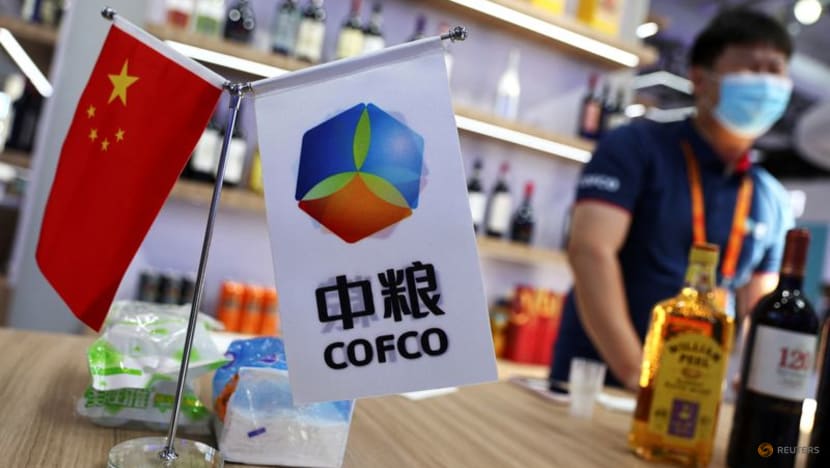China’s efforts to lower decoupling risks on show as it holds yet another global trade fair
US firms make up a fifth of foreign registrations at the China International Supply Chain Expo - a tally described by the organiser as “much higher than expected”.

A Chinese flag and a flag of China Oil and Foodstuffs Corporation (COFCO) are displayed at a booth during the 2022 China International Fair for Trade in Services (CIFTIS) in Beijing, China. (File Photo: Reuters/Tingshu Wang)

This audio is generated by an AI tool.
BEIJING: China is set to showcase the strides made towards self-reliance at an inaugural global trade fair this week, even as it looks to attract companies and shore up faltering foreign investments in the face of a slowing economy.
The participation of Western businesses at the China International Supply Chain Expo will also be in focus as Sino-US ties warm up following high-stakes talks between the countries’ leaders earlier this month.
China has promoted the five-day event - which begins in Beijing on Nov 28 - as the world’s first supply chain expo at the national level.
It will be the latest in a series of global trade shows China has held in the second half of the year. At least two have already taken place this month alone, the most recent being the Global Digital Trade Expo in Hangzhou last week.
Chinese state media have framed these events as a sign of Beijing’s contributions to the global economy and its commitment to international trade.
A quarter of the 515 companies and institutions participating in the supply chain expo are foreign, hailing from 55 countries and regions, said event organiser the China Council for the Promotion of International Trade (CCPIT).
US firms make up around 20 per cent of the foreign registrations, with the likes of Amazon, Apple, Tesla, Intel, HP and Qualcomm among the line-up. European companies make up 15 per cent.
The number of US exhibitors is “much higher than expected”, according to the expo organiser.
"We hope that the participating US companies actively engage in the expo, yielding fruitful outcomes," said CCPIT Vice-Chairman Mr Zhang Shaogang in a press conference last week.
Related:
SHOWCASING SELF RELIANCE
China’s steps towards self-reliance are set to be on display at the supply chain expo amid Western moves to de-risk from the world’s second-largest economy.
Chinese state-owned food processor COFCO and pharmaceutical giant CSPC will showcase their supply chains as leading examples for Chinese industrial giants, said Mr Zhang as reported by the South China Morning Post.
The spotlight will also be on Chinese automobiles from a “fully self-sustained” manufacturing chain.
While Beijing’s push for self-reliance dates back to the Mao Zedong era, the concept saw a domestic resurgence in 2018 under President Xi Jinping as the pain of a trade war with the US made itself felt.
US President Joe Biden has retained the Trump-era tariffs on Chinese goods while also adding new restrictions curbing the export of advanced semiconductors to China.
Mr Xi has made clear that China is not adopting a closed-door policy even as he espouses the importance of self-sufficiency.
"Only by opening up can China realise modernisation,” said the Chinese supremo during talks in Beijing with New Zealand’s Prime Minister Chris Hipkins in June.
“We will continue to vigorously promote high-level opening up and better protect the rights and interests of foreign investors per the law.”
THAW IN US-CHINA RELATIONS
American representation at the supply chain expo has been warmly received by the organiser.
"As they progress in their own development, we anticipate their positive contribution to fostering healthy, stable and enduring development in Sino-US relations,” said Mr Zhang from the CCPIT.
The hopeful outlook follows the landmark meeting between Mr Biden and Mr Xi in San Francisco on Nov 15, where both sides agreed to resume high-level and military communications, among other things.
Signs of a thaw between the two superpowers could already be seen before that, with a raft of American officials visiting Beijing as well as diplomatic engagements in Washington involving China’s top diplomat Wang Yi.
The growing rapprochement was also reflected in the attendance of the 6th China International Import Expo, held in Shanghai earlier this month.
Washington marked its first official participation in the trade fair by sending its strongest-ever delegation. A US agricultural product pavilion was also set up, yielding more than half a billion dollars worth of deals.
Overall, deals worth US$78.41 billion were signed across the event, a 6.7 per cent on-year increase, according to the expo organiser.
China’s state news agency Xinhua said the outcome is a clear sign that the global import fair is a “strong propeller” of global economic growth.
SHORING UP FOREIGN INVESTMENTS
China has been trying to attract foreign investors and inject fresh momentum into its economy as a post-COVID recovery stutters, weighed down by bilateral tensions with the US, a domestic property downturn and record-high youth unemployment.
A key gauge of foreign direct investment into China recently turned negative for the first time in 25 years, indicating that foreign companies are pulling money out rather than reinvesting in their operations.
Direct investment liabilities were a deficit of US$11.8 billion in the third quarter, according to China’s State Administration of Foreign Exchange. They were positive at $14.1 billion for the same period a year ago.
The Chinese government has been taking steps to improve the situation. Capital controls were eased in Beijing and Shanghai in September, allowing foreigners to move their money freely in and out of the country.
Last month, China’s top legislature approved one trillion yuan (US$140 billion) in government bonds to support the economy.
Newly-minted Finance Minister Lan Foan said earlier this month that the issuance and use of government bonds will be accelerated.
"The Ministry of Finance will continue to implement a proactive fiscal policy, focus on improving efficiency, and better play the effectiveness of fiscal policy," said Mr Lan, who also noted the "complex domestic and international situation".













